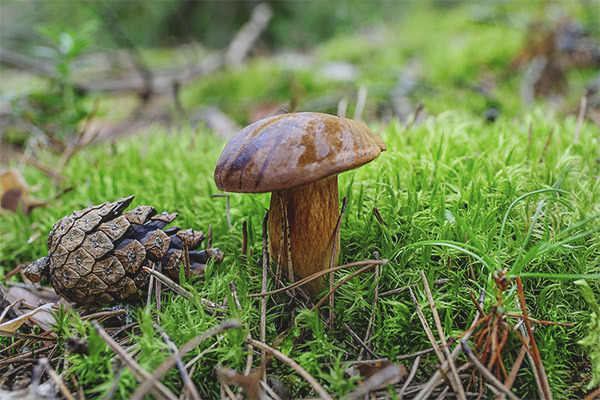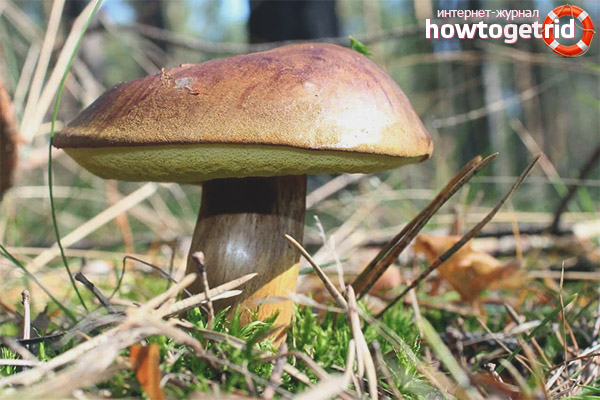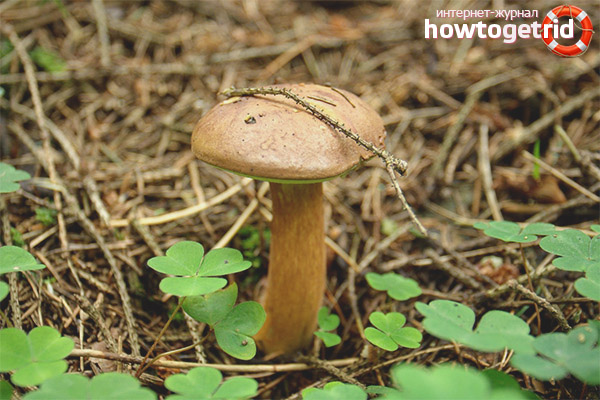The content of the article
Fans of mushrooms know firsthand how important it is to harvest and bring the “right” harvest. It refers to a delicacy that is suitable for human consumption and does not harm human health. Today we look at the Polish mushroom, which is otherwise called brown or pansky. Another name is a flywheel. But let's not get ahead of ourselves, we will study the most important aspects in turn.
Description
- According to their dimensional features, the presented specimens do not differ enormously. The length of the mushrooms grow up to 15 cm, the same can be said about the diameter (it is slightly smaller). However, it all depends on the environment in which the fungus grows. Some instances grew more than these indicators.
- The hat is brownish in color with reddish or brownish patches. It can reach chocolate or brown-red. An interesting feature is that the hat may darken in cloudy and rainy weather. If you sound the diameter of the hat, it ranges from 4-12 cm.(sometimes 15).
- The presented copy is ranked as a family of tubular, flat. The bottom section of the hat is pigmented with a very delicate yellowish-beige shade. There may be glimpses of gold, as well as greens or olives. The tubes are pigmented light, reaching 2 cm in length. If you exert mechanical pressure on them, the color will change and become green or bluish.
- Initially, these mushrooms have a rounded hat, with the passage of time it flattens out and gradually reaches a flat state. The surface is dryish, similar to velvet. This skin becomes shiny and oily when it is damp or raining outside.
- The soft part is dense in structure, rather fleshy, pleasant in smell. It is characterized by a yellowish or white tone, which turns brown when approaching the cap. The flesh is bluish, then it brightens. The part that was walked with a knife was originally blue, then painted in violet-gray with a red tint.
- Leg mushroom length is about 4-10 cm, sometimes more. It varies in width from 1 to 4 cm. It is colored brownish, brownish or light beige.In the lower part of the trunk is light, in the middle it darkens and brightens again to the upper section. If you press the foot, it will get a bluish tone. According to its format, the base is cylindrical, then narrows, then expands, resembles waves.
Edibility
- These wonderful creations of nature are allowed for consumption in food, they are endowed with a mass of valuable qualities, therefore, are considered welcome guests at each table. Mokhovik is famous for its pleasant taste and smell; the hostess will receive true pleasure from its cooking.
- Dimensions can be attributed to the positive characteristics of Polish mushrooms. Despite the rather large size, the pulp, the leg and other parts of the fungus do not have the ability to absorb harmful compounds (heavy metals, impurities, etc.). Even if the collection was carried out in dirty areas, you can not worry about the fact that the mushrooms will be poisonous. They are enough to first process and start cooking.
- The danger lies in the fact that a worm can be found in the pulp or other parts. He literally in a couple of hours will spoil the whole basket, making the mushrooms unsuitable for further consumption.Therefore, when collecting a special attention is paid to integrity, it is necessary to consider mushrooms, and not send them to the basket without thinking. If the affected area is small, you can eliminate it by cutting it with a knife. In cases where the affected leg turned out to be with the cap, then such an instance should be eliminated. Also, you can not eat too old foods.
- Mushrooms can be stored in their original form for no longer than a day, then they are processed. First, it is necessary to thoroughly wash off the remnants of the soil and foliage. Then cut rough areas at the tip of the trunk. Next is the soaking of mushrooms for a third of an hour. To this end, preparing a salt solution in cold water. If there are worms, they will die and float. Dirt, in turn, will fall off and sit on the bottom.
- Specialists who have built a career in the culinary field prepare thousands of different dishes based on these gifts of nature. Mistresses roll mushrooms together with marinade, fry, stew and boil them. Some mushrooms subject to drying, freezing and other cunning manipulations. Act with your personal preferences.
Sprouting
- Not everyone has knowledge of where these specimens are found in nature. Most of the dispersed in European countries. There are mushrooms in the Baltic States, the Czech Republic, Germany, Belarus and, of course, Poland. It was in the last named country that this variety was first discovered.
- They are also found in Western Ukraine, the Caucasus, and Siberia. There have been cases of the discovery of gifts of nature in the Far East. The range is wide enough, these mushrooms also grow in some parts of Australia, in the United States of America. They are seen in Mongolia, Azerbaijan, Asia.
- Mossworms mainly grow in coniferous forests. In a sense, they form a symbiosis with the root system of various plants. Mushrooms are also often found under spruce and pine trees. They can be found in mixed forests and among deciduous trees.
- In most cases, Polish mushrooms are found under beech, chestnut, oak, pine or spruce. The most favorable soil for them are sandstones, moss and base of trees. Separately, it is worth mentioning that mushrooms can grow individually or in small groups.
- It is worth noting that the presented mushrooms are rarely found in areas where the hot and arid climate often holds. Such specimens mainly grow in the zone of the northern temperate climate.
Primary processing
- Before you prepare the considered copies, they must be carefully processed. In addition, the taste of mushrooms will depend directly on the method of their preparation. Wash the product thoroughly after returning home from the forest.
- Immediately get rid of all the wormy places. Also remove leaves that might stick. Wash the mushrooms and place in a container with cold water for soaking. Put some salt in it. Leave copies for a few hours.
- After a certain time, the mushrooms will harden a little. Also worms that remain inside will die. After soaking all the garbage will settle to the bottom. Rinse the mushrooms again and start cooking.
- Consider, if you are going to cook the product, it is best to use a large container with enamelled coating. Fill the mushrooms with water and send to boil.As soon as the water boils, change it to a new one.
Today's material is devoted to the Polish mushroom, which grows in different climatic regions. These gifts of nature are not poisonous in their characteristics. They will not cause damage to human health, but on the contrary, they will be of tremendous service to the body. The main thing is to choose only high-quality specimens that are not infected with worms. Do not forget about soaking before secondary treatment.
Video: Polish mushroom (Boletus badius)














To send